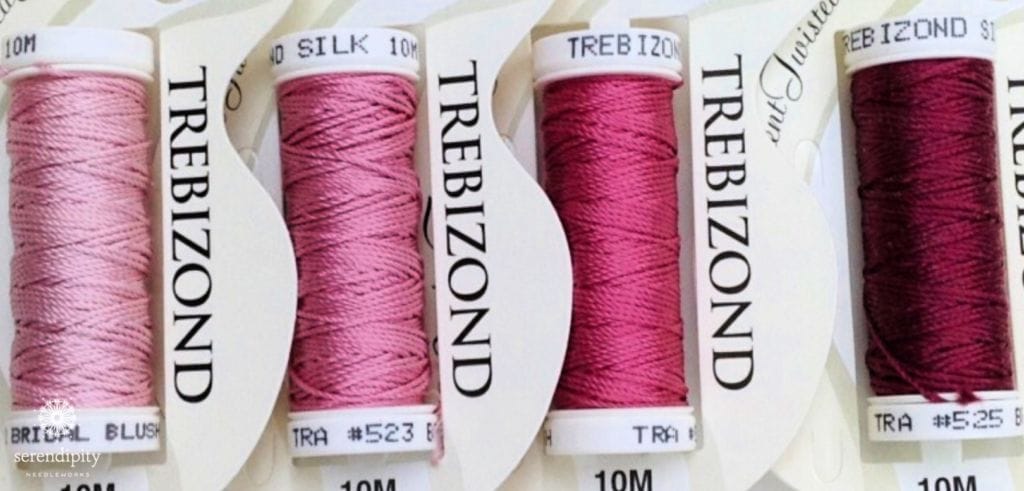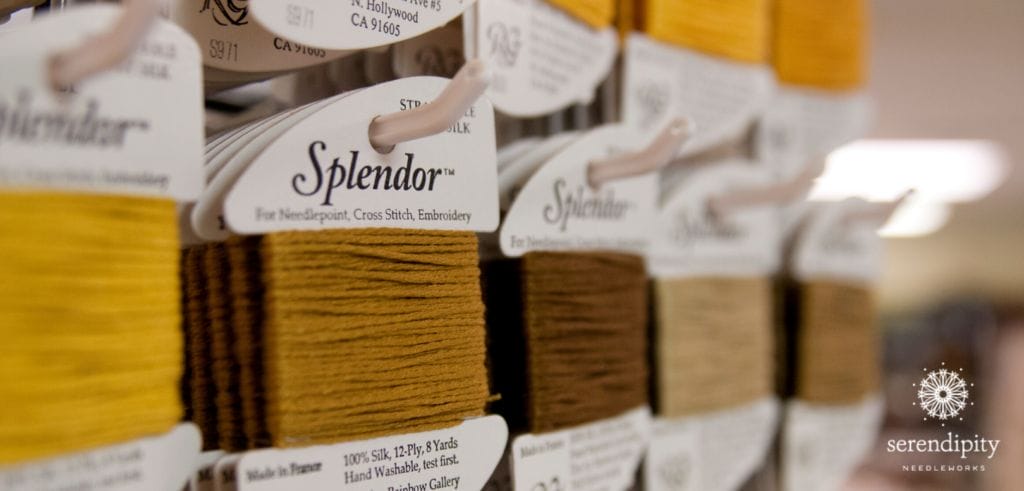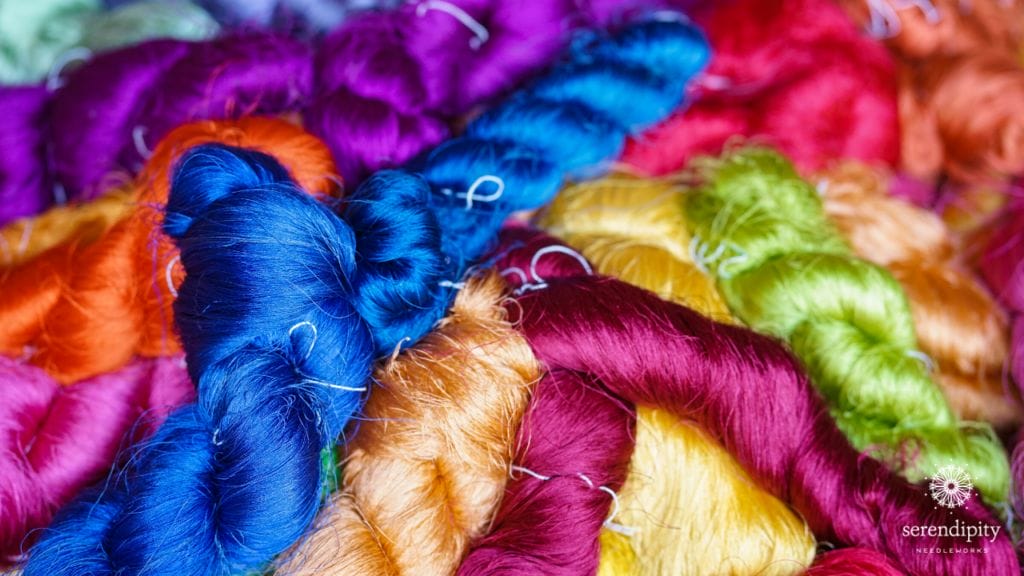Stitching with silk thread is one of my guilty pleasures when it comes to my needlepoint hobby. Now, don’t get me wrong. I adore cotton, linen, wool, metallic, and novelty threads, too, but there’s just something about silk…
Have you ever worked with silk?
It’s luxuriously soft, but it’s also incredibly strong. It has a translucent cellular structure that allows it to soak up dyes and reflect light like no other fiber.
The finest silk is pure filament silk…
naturally long strands of an unwound cocoon of the silkworm. Pure filament silk is available either flat or twisted. Flat filament silk can be a wee bit unruly and more difficult to work with, so I don’t recommend using it until you’ve had some experience working with silk threads. Twisted filament silk, on the other hand, is more manageable. Two of my favorite twisted filament silk threads for needlepoint are Soie Perlée and Trebizond.

Spun silk is made of shorter fibers.
It comes from the beginnings and endings of cocoons or from broken cocoons. The shorter bits of fiber are spun together to create threads like Splendor, Soie d’Alger, Vineyard Silk, and Planet Earth Silk. Spun silk also has a beautiful sheen, but it’s not quite as shiny as filament silk. It’s much easier to work with than filament silk – and it’s easier on your pocketbook, too. 😉

Here are my top five tips for working with silk threads…
Make sure the edges of your canvas are bound.
Artist’s tape or dressmaker’s seam binding work quite well. Silk will snag very easily on even the slightest rough spot. Covering the edges of your project will protect your precious threads. And if you stitch on a wooden frame, make sure there aren’t any rough spots on it.
Speaking of rough spots, your hands can be the source of more trouble…
especially in the wintertime. I like to use a salt scrub on my hands a few times a week to keep them smooth. My favorite is Isle of Luxe Glowing Body Polish. But if you want to make your own salt or sugar scrub, click here for a variety of easy recipes.
Additionally, I use a thick, rich hand cream every night before I go to bed. Mama gives me a new tube of Ahava every year for Christmas (a little goes a long way!) and I pick up a tube whenever I can find it. Of course, you’ll want to be sure your hands are clean before you begin working on your project, too.
Use a new needle whenever you start a new project.
Yep – you read that right! Your needle is one of the most important tools that you’ll use in your needlepoint hobby. And needles are relatively inexpensive, so go ahead and “splurge” on a new one whenever you begin a new project. Be sure you’re using the right size needle for your canvas, too. There’s not much worse than using a rusty, bent needle that’s the wrong size for the canvas mesh that you’re stitching.
And be sure to tune in at 3:00 p.m Central time this afternoon to Needlepoint TV where I’ll share some more tips about needles! (If you’re reading this after Thursday, February 13, 2020, please visit the Serendipity Needleworks YouTube channel to watch the recording. And while you’re there, click the red subscribe button so you’ll get a notice every time something new is posted!)
Use short pieces of thread to ensure maximum shine!
Yes, I know it’s tempting to cut long pieces, but your silk thread may begin to look shabby if you take this short-cut. The more a thread passes through the canvas, the more wear and tear it receives – and the more likely it is to begin to fray and get fuzzy. Ideally, your thread should be between 15″ and 18″ long. And remember to stop and let your needle dangle every so often to allow your thread to return to its natural twist. Finally, use a laying tool if you’re working with stranded threads, like Splendor or Soie d’Alger.
Use common sense when caring for silk
Silk has a reputation for being delicate, but it’s actually one of nature’s strongest fibers. It’s also notorious for being “dry-clean-only”. While it’s true that silk really does respond better to dry cleaning, it’s highly unlikely that anything you stitch will need to be dry-cleaned on a regular basis. Please don’t let the fear of high maintenance deter you from using silk thread on your needlepoint projects. It’s such a joy to stitch with that I’m sure you’ll be a convert soon if you’re not already. 😉
My all-time favorite silk thread is, undoubtedly, Splendor by Rainbow Gallery.
It’s super easy to work with and it comes in a rainbow (teehee!) of luminescent colors. I especially like to use it on 18 mesh canvas with a #22 tapestry needle.
What’s your favorite silk thread? Tell me in the comments box below and I’ll enter your name into this month’s drawing for a Valentine Bouquet of thread.
Alrighty, my friend, that’s all for now. Have a wonderful rest of your day and I’ll see you on the Serendipity Needleworks Facebook page this afternoon (and every Thursday!) at 3:00 p.m. Central time for another new episode of Needlepoint TV.
Until then, happy stitching!
XOXO






Like I really like Splendor. First few times I used I did not like it but now I use it more and more. Still trying to figure out the metallics in the Rainbow Gallery line.
Thank you for taking the time to share your thoughts with us here, Laraine. 🙂
Splendor does have a tendency to “grow” on you, doesn’t it? And thank you for letting me know that the Rainbow Gallery metallic threads are of particular interest to you. I’ll do my best to include some info on them in upcoming blog posts.
XOXO!
Ellen
I love silk and ivory.
It’s one of my favorite threads, too, Cookie! 😉
This is a great blog, with information that is very helpful. I have to ask you a question about a particular silk thread I bought.
I only bought a limited number of skeins, and they are from a company called Belding Bros & Co. It is called FILO Silk. it’s very shiny, very beautiful, and very old. It was sold as part of an exhibit of needlework done by a particular Catholic sister in the 1950’s at the College of St. Benedicts in St. Joseph, Mn. The nuns, at the exhibit, told us that these silk fibers were down in their vaults for all these years. Now what kind of silk would this be? Is this the “real” silk you talked about last night in Fiber Talk? The nuns, amazingly, were selling them for $.30 per skein.
Hi Theresa!
Thank you for taking the time to write. I’m so glad you liked my blog post about silk thread. 🙂 I’m happy to help you with your question – and what a wonderful treasure you have acquired. If the thread is identified as FILO silk, it’s actually spun silk, not reeled silk. That doesn’t make it any less precious, though. I hope you have a very special project that you can use it on. I just L-O-V-E stories like yours! It makes that thread that connects us all together that much more “real”.
Happy stitching!
XOXO!
Ellen
I haven’t worked much with silk threads, in my short needlepoint journey, but I do enjoy working with Splendor. I like it so much I don’t mind having to use a laying tool. ????
Hi Anita!
Your note made me smile! I love that you’re enjoying working with Splendor – and that you’ve taken to using a laying tool, too. 🙂
Thank you for taking the time to share that with me here.
XOXO!
Ellen
The more I use Spendor the more I like it! I also really, really enjoy Soie d’Alger (but never know how to pronounce it!)
Hi there, Sue!
I’m tickled to read that you’re enjoying using Splendor. It’s such a beautiful thread!!! And, of course, so is Soie d’Alger. That French name can be a little tricky, so here’s a pronunciation tip for you… try saying swah daljhay. 😉 I hope that helps…
Have a terrific Tuesday!
XOXO!
Ellen
Silk threads are one of my favorite also. Splendor from Rainbow Gallery has so many luscious shades available. I am not a fan of having to lay threads (too lazy) but it is definitely worth the effort for that shine! Thanks for the info!
Hi Karen!
Thank you for your note. It’s great to hear from you! I agree – the colors of Splendor are exquisite! That’s one of the reasons I love it so much!
I’m so glad you enjoyed the blog post. 😉
Happy stitching!
XOXO!
Ellen
Splendor and Silk and Ivory
Hi Emily!
Those are two of my favorites, too! Great choices! Thank you for taking the time to share with me here.
Happy stitching!
XOXO!
Ellen
Alice Turk likes Splendor and Soie d’Alger.
Hi Alice!
I love both of those threads, too! Great minds think alike… tee hee!
Thank you for taking the time to share your thoughts with me.
Happy stitching!
XOXO!
Ellen
I love Splendor as well. Even though you have to ply the threads, an extra step, it always threads smoothly and lies well.
Hi there, Liz!
How nice to hear that you like Splendor, too! It’s such a wonderful thread. And I agree, even though it has to be stranded to get the best effect, it’s well worth the effort!
Thank you for taking the time to share your thoughts with us here.
Happy stitching!
XOXO!
Ellen
Splendor silk
A gal after my own heart! Thank you for taking the time to share your favorite silk thread with me here, Dana!
XOXO!
Ellen
A really nice article about silks. Thank you
Thank you, Linda! I appreciate your kind words more than you’ll ever know!
XOXO!
Ellen
Love this post and others like it. Thank you for the voice if experience. I am currently using a few different silk threads in projects. Some are new to me like Vineyard, Planet Earth, Pepper Pot and Baroque Silk by The Pure Palette. I actually love them all. I especially like not having to strand. Baroque Silk has been fun. I have two projects waiting that have some straw silk — I am a little hesitant to try these without guidance.
Soie d’Alger is my favorite when I am feeling patient. But then I am a Francophile and love all things French ????
Thank you for your kind words about my blog post, Pamela! I’m so glad you found the information helpful. 🙂
It sounds like you’re having a silk-fest! I, too, love Vineyard, Planet Earth, and Pepper Pot. I’ve not used Baroque Silk very much, so it’s nice to know that you like it. I may have to see if I can find some to play around with. 😉
Straw Silk isn’t as hard to work with as you might imagine. It just takes a little more time and patience to get it to cooperate. And be sure to use a laying tool. It’s very much worth the extra effort.
I’m a Francophile, too, so I completely understand your love of all things French. We are kindred spirits, indeed!
XOXO!
Ellen
Thanks for the tip about a sugar or salt scrub. I plan to ask for one for Valentine’s Day and let Jamie soften my hands.
My favorite silk thread is Silk and Ivory. I do remember using Trebizond and it did stitch easily.
You’re very welcome, Susan! I’m glad you enjoyed the blog post. Those sugar/salt scrubs are miraculous! I hope you were able to get your Valentine treat. 😉
And thank you for sharing your favorite silk thread with us here!
Happy stitching!
XOXO!
Ellen
Like you, my all time favorite silk is Rainbow Gallery Splendor Sik.
Hi Judy!
Thank you for taking the time to share your favorite silk thread with us here. It’s hard to beat Splendor, isn’t it?! The colors, ease of use, and availability all add up to a perfect combination in a thread.
XOXO!
Ellen
My favorite silk thread is Needlepoint Inc.
Hi Marilynn!
Thank you so much for sharing your favorite silk thread with us here. I’ve not used Needlepoint Inc. silk thread very much, but I remember liking it a lot, too.
Happy stitching!
XOXO!
Ellen